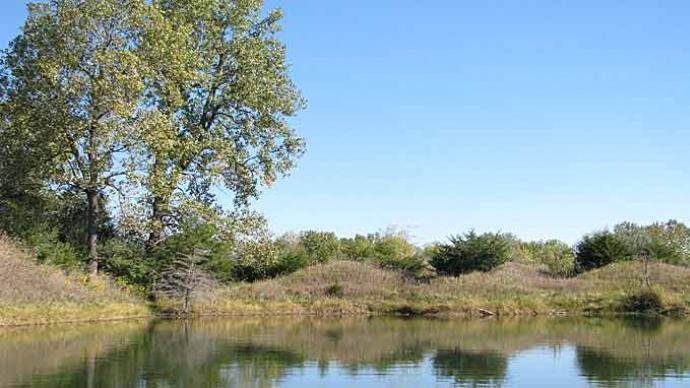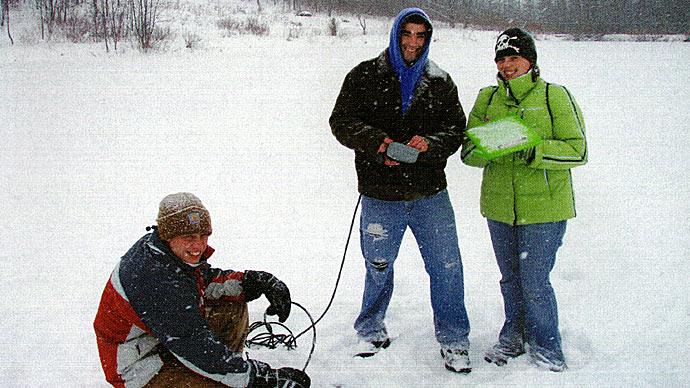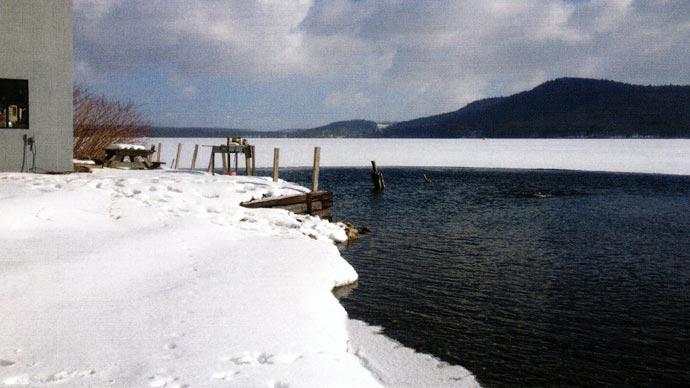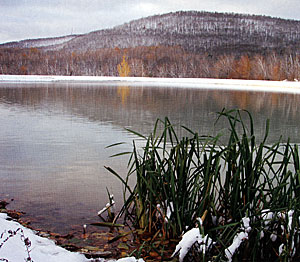
The college van was slipping and spinning up the steep slope a little more than I would have liked on that cold February day 10 years ago. As the van churned up the forest road on snow, ice and slush, I was comforted that it had good tires and was loaded with a least a ton and a half of college students who could be used for both weight for traction and muscle for pushing if we got stuck. A thought crossed my mind that a college administrator might find this journey questionable ... but my angst vanished quickly when the reason for our cold journey came into view... Looking Glass Pond. The class was on a mid-winter water quality investigation to this newly created jewel, just southeast of Lake Ontario near the town of Fulton, northwest of Syracuse.
This pond had been built by the dedication of local sportsmen as a bass pond during the last year. The pond was thoughtfully designed with input from many local anglers and experts. The pond builder was instructed by the sportsmen to leave standing deadwood around much of the pond perimeter, brush piles and stumps adjacent to deep water. Dead woody debris dominated a large, tangled section of shallow water for shiners to breed and avoid predation. There is no lack of structure for a variety of fish species.
As we swung the van into the parking lot, I was excited. We had made it to the destination unscathed and in good spirits. Students scurried, gathering ice augers, depth finders, water analyzers, transits, tape measures, test kits and a bunch of other necessary gear to run water-quality profiles across the entire pond. Gear in tow, we started down the trail toward the pond when an ill wind hit us. "What the heck STINKS?" sneered one student. The air carried a foul odor. A nasty, stinking, rotten stench smelled like someone was making rancid hard boiled eggs, right under our noses. "Uh oh, hydrogen sulfide," I whispered. As we neared the pond's overflow, the stench strengthened.
Brown, tea colored water bubbled from under the ice near the monk-style water controlstructure and was flowing nicely over and out. The smell of rotten eggs was so strong ... it was almost sickening.
This was a big hydrogen sulfide problem.
Before I finish the rest of the story and tell you why hydrogen sulfide was in this pond let's talk about the ice on your pond, first. Water is most dense (heaviest) at 4C or 39F. On top of that water is 3C water (37.1F), on top of that is 2C water (35.5F), on top of that is 1C water(34F) and then on top of that is ice (0C or 32F). Ice is the least dense (lightest) of all of these, so it floats, just like that ice cube in your glass of tea. The pond is stratified INVERSELY to the way it would be in summer. In winter, the warmest water is on bottom and in summer, the coldest water is at the bottom. Sometimes water will get a little warmer near the sediments in the winter (greater than 39F) due to conductive heating from the Earth. Even though this warmer water may be lighter, ice is on the pond, wind won't get to the water, so it will not mix. The density difference is not enough with this small change in temperature to cause mixing purely by density alone.
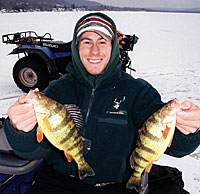
Oxygen in a pond essentially comes from two sources... diffusion from the atmosphere and photosynthesis from green plants and algae. If your pond freezes, no substantial diffusion from the atmosphere happens, eliminating the diffusion pathway. Plants need sunlight to make oxygen. Clear ice has the same transparency as water. So, if your ice is crystal clear, good light penetration through ice keeps the photosynthetic pathway intact. Clear ice is rare. Milky ice and snow on that ice are more common. Cloudy ice and snow piled up effectively draw a shade over the pond and reduces (or even eliminates) the photosynthetic pathway. I like to think of ice coming on the pond as turning over an hour glass. The oxygen in the water the day ice comes on the pond is the amount fish have to survive until the day the ice leaves. When the hour glass runs out oxygen runs out, and fish die.
What should you do? I have seen the ambitious pondmeister running around his pond drilling holes with an auger hoping to help his fish avoid winterkill. This won't work. If you want to aerate, read Dave Willis' article in the November/December 2008 issue of Pond Boss and learn about aeration and superchill. Winter aeration can be done effectively with proper planning.
If you don't want to aerate, get out on the pond and shovel or plow off the snow. This will allow better light penetration through ice and jumpstart the photosynthetic pathway. If you can, pump water on the ice with a portable sump pump to melt snow and freeze clear. I found a small pump that plugs into the cigarette lighter plug on my 4-wheeler. Hooked to a small garden hose, this makes a neat Zamboni-type Contraption to pump water on ice and make it more transparent (and smoother for ice skaters). In all cases, you'll want dissolved oxygen levels in your pond above 5ppm to avoid winterkill. Some fish will tolerate lower levels of dissolved oxygen, but I think 5ppm is a good target good to shoot for.
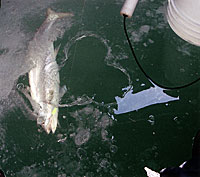
Hydrogen sulfide is a gas dissolved in water present under anaerobic conditions as a byproduct of the decomposition of organic matter or directly from a sulfur spring.
Hydrogen sulfide is toxic to fish in extremely low levels. Humans can smell hydrogen sulfide at 2-3 ppb (that's parts per billion not million) and that amount is enough to kill most fish. Rule of thumb: If you can smell it ... fish are probably dead.
Back to the pond.
Dead trees left in Looking Glass Pond weren't "grubbed out" during construction and were decomposing and releasing sulfur into overlying waters. After auguring holes in the ice across the entire pond, students measured dissolved oxygen and hydrogen sulfide levels at the bottom and every 2 feet to the surface. Conditions were not good. Looking Glass Pond is 10 feet deep. Anoxic and high hydrogen sulfide conditions came within 2 feet of the ice. We had stocked fatheads and golden shiners earlier that year. I feared for the lives of these fish, hoping they could avoid toxic waters and stay close to the top, more safe waters.
Students also took alkalinity and hardness readings. Alkalinity was 0 and the hardness as 17 mg/1. Yikes! Alkalinity is the power of a mineral solution (in this case water with calcium carbonate dissolved) to buffer an acid. The pond is located at the top of a mountain in the middle of a hemlock forest. Water picks up alkalinity from soil and rocks as the water percolates on its way to the pond. Located on the top of the hill, this pond has a very small watershed (almost none) and what watershed it does have is all hemlock forest (acid also). Rainwater by its very nature is acidic (after all, it is distilled) with a pH of 5.5 or less. Fish prefer pH from 6.2-8.2. The pH in Looking Glass Pond was 4.5. Wow! That's way low. Alkalinity in a well buffered system should be at 100-400 m,-/l to resist changes in pH. The zero reading in this pond may be a result of the detectability of the water testing kit we were using. I am sure there was some alkalinity; we just couldn't read it below 17 mg/1.
The same processes that give alkalinity to the water also tend to lend hardness. Hardness is the concentration of calcium and magnesium ions in water and should be 100-400mg/l also. Hardness is a crude measure of productivity in a system. The hardness in this pond was very low and is a cause for concern. See Lusk's excellent comments in Pond Boss (November/ December 2008) to correct for an alkalinity/ hardness imbalance.
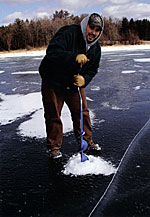
Back at Looking Glass again. Two students used a water bottle to take the ammonia levels at the bottom and the surface under the ice. Ammonia comes from metabolism of proteins, such as bacteria eating dead plant material on the bottom and is usually present under anaerobic conditions. I was watching the test tube as the student was dropping a reagent in... it turned yellow, really yellow. That meant there was a lot of ammonia in the water. We won't go into ammonia dynamics here, but I will say that whole ammonia is not good for fish and should be less than 1 ppm. The level in Looking Glass was a little over 1 ppm. Not good.
Did the fish in Looking Glass live? Did they make it to Spring? Amazingly, yes. Some made it through the winter. The lens of water nearest the ice was hydrogen sulfide free and apparently had just enough dissolved oxygen in it to keep those minnows alive. They were survivors! This leads me to the conclusion that if these fish can survive this water quality nightmare, then small actions you take on your pond could help avoid winterkill.
Work to have clear ice over some of your pond. On sunny days, the photosynthesis pathway plays a crucial role to the addition of much needed oxygen. And, don't discount the value of shallow aeration or wind powered aerators.
What's happened to Looking Glass Pond? There has been no repeat of the hydrogen sulfide event that we witnessed that first year. I have been back each year since and have seen nothing like what we saw that first winter. Alkalinity and hardness are still low, as is pH. During the first few years, shiners and minnows thrived. Largemouth bass were introduced in year two. Now in year 10, the lake is bass on bass. The local sportsmen stocked bluegill to add much needed forage.
I will let you know how that goes....
Reprinted with permission from Pond Boss Magazine

